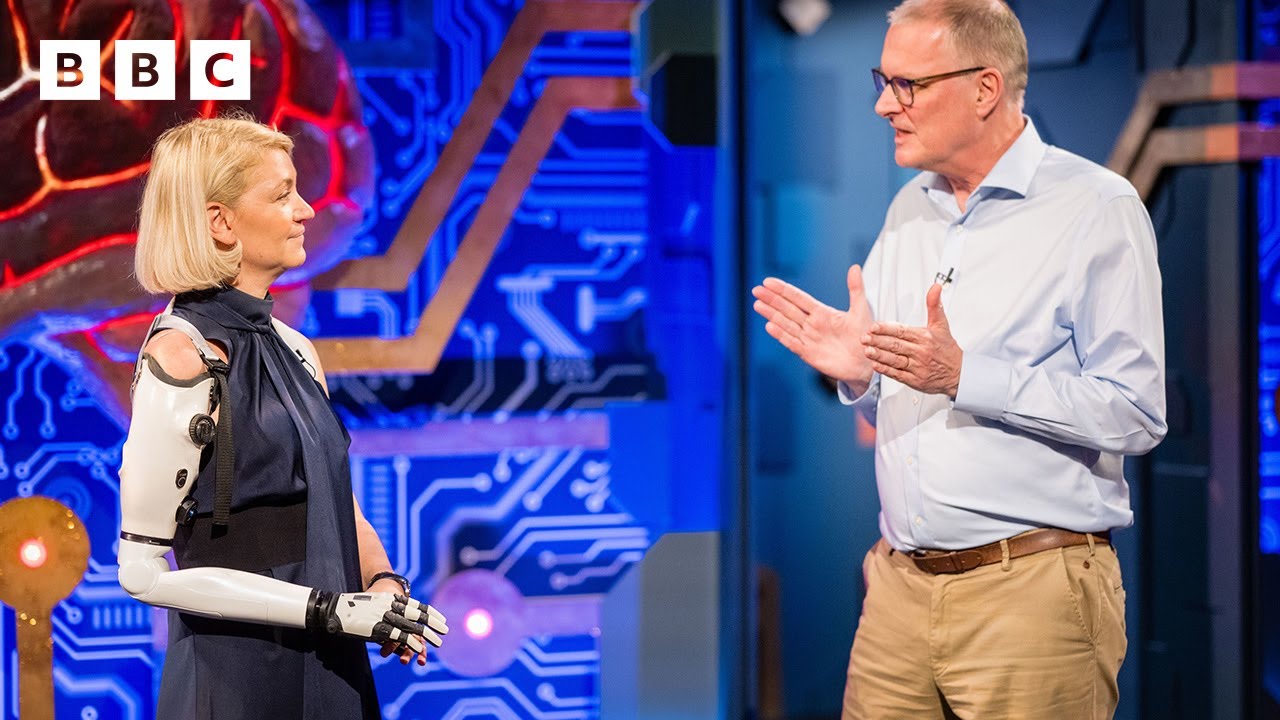Incredible bionic arm powered by A.I. and THOUGHT 🦾 | BBC
Now Sarah you have a truly remarkable story will you share that with us yes of course so um just about 12 months ago I was in a terrible train accident and as a result I lost my right leg below the knee and I lost my arm um above the
Elbow oh wow that’s incredible uh and so uh you’ve been fitted with a prosthetic arm those are nothing new but what makes this one special so this one’s pretty special because this is what we call a bionic arm um and it’s powered by artificial intelligence okay now I
Understand at this point you’ve got a party trick to show us involving a can is that right yes well the first thing I wanted to show you is that I’ve got a movable wrist that can turn all the way around and then it’s got a little bit of
Power as well so let me try to crush this can for you oh oh oh okay it does work that really is quite a party trick so how does your arm know how to do that well basically the way it works is that I think about the movement that I want
To make and I twitch a series of muscles and the muscle twitches are being recorded by 16 electrodes that are positioned inside the socket and then transform that into electric impulses that run through the forearm and Powers the kovi hand my bionic hand okay and where exactly does the AI come into the
Picture so the AI is um a lot of data recording it’s basically every time I use the arm every time I make a movement it records it it starts to learn how I use the arm and it starts to predict the movements that I want to make including rotating it like
That I could watch that all night okay so the AI is being trained on your body but is your body and your brain are they adapting to the AI so I did have a lot of training to understand because it’s very different to think about a movement
And it’s more difficult to control it when it is bionic but when I take the arm off at night and I recharge it like an iPhone then I miss it how would your life have been light without this arm well I have to say that this world is being designed for people
With two hands everything think about the zipper on your coat for example or on your bag on your rock saac uh think about a parcel a packaging for everything you need to have two hands want to hold it down and the other one to to rip off um the the lid on
Something and with the arm it helps okay now this technology is evolving AI is moving very fast what do you hope this this arm is going to be able to do in the future so I really hope that this is going to evolve become even more performant because the idea is that at
The moment it takes me about 10 seconds to think about a movement and then execute it that’s the AI part that hopefully will reduce that time and become instantaneous like my other hand okay so as the AI gets better and better that’s going to help you in your life
And I really dream that one day I can go back to riding a bike and if I’m lucky maybe I can drive a car again okay Sarah that is a truly remarkable story thank you so much for sharing it with us thank you [Applause] Sarah
Professor Mike Wooldridge asks: what is artificial intelligence? He compares how AI works and learns with how the human brain functions. Exploring the roots of AI, Mike reveals how Alan Turing devised the Imitation Game – a test of whether a machine answering a series of questions could pass as a human. The audience in the lecture theatre play a real-life version of the game to find out if AI can pass this test today. In this lecture, Mike examines real-life neurons in action and explains how artificial neural networks are inspired by neural structures in the brain. To demonstrate how AI learns, we watch drones as they are trained to recognise and fly through structures in the lecture theatre autonomously. AI exploded into the public consciousness in 2022 with the release of ChatGPT and boasts around 100 million monthly users. Mike unravels the mystery of how large language models like ChatGPT work, and he finds out if one day this technology – along with a whole suite of different AI tools – will allow us to understand the animals we share this planet with. The Christmas Lectures are the most prestigious event in the Royal Institution calendar, dating from 1825, when Michael Faraday founded the series. They are the world’s longest running science television series and always promise to inspire and amaze each year through explosive demonstrations and interactive experiments with the live theatre audience.
Subscribe and 🔔 to the BBC 👉 https://bit.ly/BBCYouTubeSub
Watch the BBC first on iPlayer 👉 https://bbc.in/iPlayer-Home
All our TV channels and S4C are available to watch live through BBC iPlayer, although some programmes may not be available to stream online due to rights. If you would like to read more on what types of programmes are available to watch live, check the ‘Are all programmes that are broadcast available on BBC iPlayer?’ FAQ 👉 https://bbc.in/2m8ks6v.

1 comment
🙂